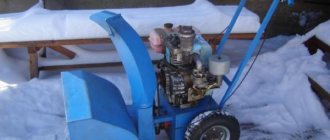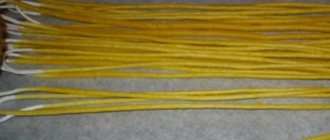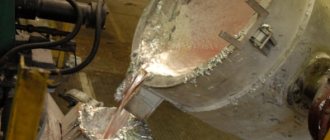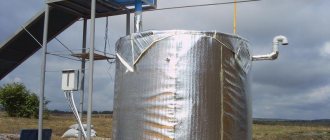Good day everyone! I’ve had a Chinese vacuum cleaner lying around for a long time (almost a year), donated by I don’t remember who, but why is it lying around idle? Yes, because it seems to be buzzing quite well, but it refuses to suck up dust and debris, the suction power is negligible! Well, I think it’s still lying around, so you can dig around, try to repair it, it won’t work, I’ll throw it out) said done!
this is our test subject
the reason for the weak suction, a small fan, the height of the blades at the edges is slightly less than 4 mm
I take a soldering iron and start sawing it mercilessly)
then I solder the sawed off parts onto the fan blades, now they are 12 mm!
I'm putting everything back in place!
now it’s no longer a Chinese vacuum cleaner, but just a monster))) it only vacuums dirt, just give it time)) after this modernization, another problem appeared, a weak filtration system, stupidly dust began to fly through the dust bag, but there will most likely be a post about this problem and its solution Later. smooth roads everyone!
“He has golden hands” - this is what they say about craftsmen who are able to assemble a miracle of modern technology from scrap materials. Despite the abundance of inexpensive ready-made equipment in stores, self-taught craftsmen successfully design and create household appliances, units for the garden plot and very effective devices for the workshop.
It turns out that you can also assemble a vacuum cleaner with your own hands. The main thing is to understand the design, find the necessary parts and allocate some free time. We offer three interesting models for independent experiments.
Air blower
Change the direction of rotation of the motor in the opposite direction. Place a cone at the very exit. Use a zip tie and a thick bag. Place the vacuum cleaner in the bag after removing the garbage container, then close the lid tightly. From the back, pull the cord through the hole made with scissors. Rewind tightly with adhesive tape. Rewind the end of the hose in exactly the same way. And connect in the usual way.
Important!
Use a thick bag, otherwise it will tear quickly. The device cannot be used for a long time; it may simply overheat and fail.
To work, you will need handy materials: a baby stroller body, a welding machine and 2 metal sheets, knives or a saw. We attach a metal sheet to the body and insert the engine from the vacuum cleaner. The shaft should be at the bottom, to which we attach the knives and metal disk. The disk is welded to the shaft. Run the wire from the toggle switch to the motor - and the lawn mower is ready
Attraction for children
You can make a whole show out of a vacuum cleaner for children. You need to switch the vacuum cleaner mode to air injection and install the hose so that the air is directed upward. Turn on the vacuum cleaner and place the ping pong ball where the air is coming out. The ball should levitate. The attraction is ready for use.
We use a motor from a vacuum cleaner. The body will be an ordinary saucepan. Next, cut a strip from a circular saw; it needs to be fastened in the center of the bottom of the pan. We attach the knife to the shaft below. Well, we attach the engine itself to the body so that it is connected to the pan. To do this, we make 2 additional holes for density. The grain crusher is ready.
Important!
Use deep, durable containers.
We change the direction of thrust of the device. The hose is used for the instrument gun, to which we attach a container of paint. For power, use a pressure reducing valve. The outer side should not allow dust to pass through; it must be sealed. You need to work quickly with such a device, as a lot of paint is consumed. Use enamel; it is advisable to try and test the device on the street for the first time.
Quite often a situation arises when a new vacuum cleaner of a modern design is purchased for the house, but the old, fully functional “hard worker” remains out of work. As a result, the old vacuum cleaner gathers dust in the far corner of the pantry according to the principle “it’s a pity to throw it away and takes up space in vain.” However, in many cases, such a technique can find a second life in a completely different capacity. Let's look at several options for using an old vacuum cleaner as a home assistant.
Despite the wide variety of vacuum cleaner models, they all work on the same principle. A fairly powerful and high-speed engine rotates the impeller, which blows a large volume of air through it. As a result, a vacuum is created at the inlet of the vacuum cleaner to suck debris into the receiver, and at the outlet there is an air stream cleared of dust by filters. It is these properties that can be successfully used for various purposes.
Air blower
If we connect the vacuum cleaner hose to the outlet, which is found on many models, then we get a very convenient powerful source of air for inflating rubber mattresses, children's pools and other similar things. Of course, you must first thoroughly clean the receiving container of the vacuum cleaner from any remaining debris and dust that has accumulated there over the previous time. In this way, we can avoid dust and dirt getting inside the object that we are inflating.
If you have a small garden plot, then an old vacuum cleaner can be used to clean the surface of the paths from dust and small debris by blowing it off. For these purposes, a nozzle with a narrow hole is attached to the end of the hose connected “for blowing”. According to the laws of physics, the air stream emerging from such a nozzle acquires high speed and effectively blows away dust, sand and other small objects.
Another place where the “old man” can be used can be a home workshop. In this case, depending on the owner’s wishes, you can use both the “input” and the “exit” (for example, collecting wood dust from a jigsaw, blowing dust off the surfaces of objects prepared for painting, etc.).
Smoke exhausters and fans for boilers: advantages of use and characteristics
In fact, the decision to use a smoke exhauster for heating is not new. In thermal power plants used in industry, traction and blowing machines have been used for a long time. After all, when a large amount of fuel is burned in furnaces, the efficiency of the combustion process plays a huge role.
Today, smoke exhausters have moved from large industrial furnaces to small private homes that use solid fuel boilers. Their use in boilers operating on solid fuel provides many advantages.
Namely:
- The efficiency of the unit increases;
- It becomes possible to control the fuel combustion process;
- This creates the possibility of more precise adjustment of the coolant temperature;
- It seems possible to stabilize the stable operation of a heating device in conditions of poor draft in the chimney.
- Prevents smoke from entering the room where the heating equipment is installed when any firebox door is opened.
You should know that, unlike blowing machines, smoke exhausters in solid fuel household boilers are located at the end of the gas-air path, and not at its beginning. In appearance, they look like fans, the working part of which is protected from damage by high temperatures and small volatile inclusions contained in combustion products. However, the purpose of smoke exhausters is similar to blowing machines. The difference between them is that the former create a vacuum in the firebox. It is necessary for the proper functioning of each solid fuel device and is about 16-25 Pa, depending on various modifications. The blowing machines themselves create high pressure in the firebox, and the chimney must create a vacuum in the solid fuel boiler. Unfortunately, this may not always happen, and building a new smoke exhaust pipe is very expensive.
A fun attraction for children
Despite the abundance of modern toys, children will gladly take part in the fun called “flying ball”. For these purposes we will need the following things:
- A vacuum cleaner with a hose connected “for blowing”;
- Several table tennis balls;
- Thin pins;
- Washed polystyrene jars (for example, from children's cheese like “Tema”, “Agusha” or the like);
- Small round beads with a hole (you can borrow them from your mother or grandmother).
We begin making a “flying ball” by carefully piercing the wall of the ball on two opposite sides so that it appears to be “attached” to a pin. Then we start cutting out the propeller that will be attached to the top of the ball. In this case, it will be convenient to use stationery scissors, with which we carefully cut out a strip of about 5-7 cm long and about 1 cm wide from a polystyrene jar. It is better to cut this strip with some margin, so that later you can adjust the propeller.
We pierce the propeller exactly in the middle and place it on the axle using a pin. To make the propeller rotate easily, we place beads on top and bottom of the polystyrene strip, which will act as bearings. We bend the upper tip of the pin so that the propeller rotates easily and at the same time does not have too much play on the axis.
The “flying ball” is almost ready. Now all we have to do is turn on the vacuum cleaner and adjust the air supply from it so that the ball’s propeller rotates under the influence of the jet directed from below, and the ball itself floats in the air. If it doesn't work out the first time, it doesn't matter. Gently bend the polystyrene blades over a lit gas burner so that they create a lifting force as they rotate.
A correctly adjusted “balloon” floats freely in the stream of air that comes out of the vacuum cleaner. In this case, you can make it maneuver in the air following the smooth movement of the hose. To make the ball look elegant, you can paint it, for example, in the form of a cheerful character, Carlson, who lives on the roof.
Many owners of household appliances do not think at all about what can be done from an old vacuum cleaner. Quite often, they purchase a new vacuum cleaner while the old one is still in working order. It can be a shame to throw away an outdated device. At the same time, it occupies a certain place in the apartment. Such a device, which has suddenly become unnecessary in the house, can still serve the owners.
True, in a completely different capacity. There are a huge number of vacuum cleaner models in the world, but they all work. The operation of a sufficiently powerful engine with a large number of revolutions is the key to rotation of the impeller. It blows a significant amount of air through itself. A vacuum is created at the inlet of the device, allowing debris to be sucked into the receiver. At the outlet, a stream of air is created, cleared of dust by filters. This can be successfully used for various purposes.
For example, you can use a vacuum cleaner to inflate children's pools and swimming mattresses. Many models of modern vacuum cleaners have, in addition to an inlet, also an outlet. It is enough to connect a hose to it to create a fairly powerful source of air. Naturally, before using the device in this capacity, it is necessary to properly accept dust. After all, during its operation, a lot of debris accumulates there. Such cleaning will also be useful for the engine, since dirt can penetrate into it.
The air blower obtained in this way will be useful to owners of country houses.
The device can be successfully used to clean paths of any debris. To do this, a nozzle with a narrow hole is installed at the end of the hose. A jet of air flies out of such a nozzle at high speed, capable of sweeping away dust, dirt, and fallen leaves from the surface.
Owners of old vacuum cleaners who have their own workshop at home may well find more than one use for them. Outdated units may blow dust off surfaces prepared for painting. Or it can function as a chip extractor, collecting wood or metal dust.
Ejector vacuum cleaner
UNION OF SOVETSNIKHOTSIALISTICH ESNIKHEPUBLIK 1447347 A 4 A 47 1. 5/18 STATE COMMITTEE OF THE USSR ON INVENTIONS AND DISCOVERY GE.:, 1, , city. "N A SECOND CERTIFICATE borochnoy the height of the spine is clear-established (57).
The invention relates to technology. The purpose of the invention is productivity and efficiency. An ejector vacuum cleaner contains in pipe 1 an inlet converging nozzle 2 and an outlet converging nozzle 3, which has a channel of constant cross-section turning into a diffuser, a pipe for supplying a gas working medium to the inlet nozzle, a pipe 4 for suction of debris and dust, located between nozzles 2 and 3, and filter 5. The values of the diameter of the nozzle 10, the length of the nozzle channel 3 and the total length of the channel and diffuser are in the following relationship: 11(1(2.8 s 1, where 11 is the length of the channel of constant cross-section, d is the diameter of the nozzle for supplying gas working environment, 1 is the total length of the diffuser and channel of constant cross-section, with 0.3 d(1( (1.125 1. 3 illus. The invention relates to cleaning equipment and can be used in various sectors of the national economy, in particular in the automotive industry for cleaning from dust and debris in the interior, trunk, engine compartment of a car, in mechanical engineering when cleaning production areas, for cleaning parts, components, assemblies from mechanical dust, small chips, etc. The purpose of the invention is to increase the productivity and efficiency of cleaning. In Fig. 1, a vacuum cleaner is given , lengthwise cut; in fig. 2 - dependence of the vacuum in the vacuum cleaner of the proposed design on the length of the channel of constant cross-section, which turns into a diffuser Рdisr = 1 (1 = 1 d), where Y is the coefficient of the length of the output nozzle from the diameter; nz fig, 3 - dependence of the vacuum in the vacuum cleaner on the value of pressure at the inlet Prazr = (Pvx) for the predlzgze: The nozzles accommodate a dust and dust suction pipe 4, made, for example, in the form of a fitting. Nozzle 3 consists of three sections: a tapering part a, a channel of constant cross-section b and an expanding part - diffuser c. A filter 5 is attached to pipe 1 from the side of the output nozzle 3, which is a cylindrical stz: an with a number of symmetrically distributed holes 6 on lateral surface. The end surface of the cylindrical glass is a fine filter 7, made in a mesh or wall with a number of small-diameter holes that can delay the release of the dust-air mixture into the atmosphere and control the flow rate of the outgoing jet. A flexible air suction hose 8 is attached to the pipe 4, at the end which is secured with a slotted suction nozzle 9. Pipe 1 is connected through a pipe 10 to a source of gas working medium. The vacuum cleaner operates as follows. Exhaust gas, air (ejecting) from the source of the working medium (not shown) through pipe 10 enters pipe 1, then into the converging nozzle 2. Due to the narrowing of the nozzle, the air flow accelerates, thereby acquiring high-pressure air. A jet of high-pressure air, exiting the circuit of nozzle 2, enters nozzle 3. A vacuum is formed in the cavity between nozzles 2 and 3. 1) when air exits nozzle 2 and enters nozzle 3, the flow entrains the dust-air mixture from the surface to be cleaned through nozzle 9, flexible hose 8 and pipe 4. Thus, firstly, ejecting air (active flow) and the flow of the ejected dust-air mixture. Next, in a channel of constant cross-section of nozzle 3, two flows are mixed - ejecting and ejected and their pressures are equalized to create a vacuum. From part nozzle 3, the dust-air mixture enters part c, which is a diffuser. Like the part in nozzle 3, which allows you to increase the vacuum in the vacuum cleaner, the diffuser part from nozzle 3 additionally increases the vacuum by reducing the static pressure at the inlet to part a of nozzle 3. The stream of dust-air mixture, leaving the diffuser (part from nozzle 3), enters the internal cavity formed by the filter 5, in which part of the dust and debris is deposited. Some of the dust and debris can immediately exit into the designated area through the holes 6 of the filter 5. The rest is deposited on the wall of the fine filter 7. If necessary, the filter 5 is disconnected and cleaned. In the proposed vacuum cleaner, the given range of changes in the length of the channel of constant cross-section with diffuser 1 of nozzle 3 with a superimposed change in the length of the channel of constant cross-section 11 was obtained on the basis of experimental studies. The dependence of the vacuum in the vacuum cleaner on the length 1 in nozzle 3 was obtained when internozzle distance E = 0.05 I and the angle of inclination of the diffuser generatrix to the axis c = 5 d = 40 mm, d = ZO = - 6 mm (0.15 s), A = 12 (0.30 d). 1.1 a fchg. 2, options for vacuum cleaners are considered, justifying the choice of boundaries of length 1, nozzle 3. In the vacuum cleaner (1.0,30), a rarefaction is created (400 mm of water column, which does not meet the minimum rarefaction. This design option 35 is not included in the proposed range of changes 1. In vacuum cleaner (1) O, ZN), for example, at 11 = 0.5 d, a vacuum is created )400 mm zod. Art. and reaches a value of =520 mz; water Art., exceeding the minimum vacuum for car vacuum cleaners. In a vacuum cleaner (1)2,M), for example, at 1=ZA, a vacuum is created reaching =930 mm water column, and although it significantly exceeds the minimum vacuum, it can be obtained in a vacuum cleaner with a nozzle length of 3 ==2.375 N, which will have technical and economic advantages, since smaller dimensions lead to a reduction in mass, metal consumption and, as a consequence, a reduction in the cost of manufacturing such a vacuum cleaner. The optimal design option for a vacuum cleaner would be a vacuum cleaner with a nozzle length of 31 = -2.8 d with a channel length of constant cross-section of 11 = 1.125 d (optimal nozzle), in which a vacuum equal to 940 mm of water is achieved. Art. In a vacuum cleaner, the use of nozzle 3 with 1)1.125 d is impractical, since vacuum in it can be obtained at 11(1.125 I, which is also more expedient from the point of view of technical and economical conditions. The vacuum cleaner showed high cleaning ability. 3 technical indicators. It should be noted that in an optimal vacuum cleaner, the vacuum increases by 2.6 times in comparison with the minimum vacuum requirement for car vacuum cleaners. Such a vacuum cleaner showed high dust cleaning efficiency during its operational testing. Even small pebbles and other objects up to 7 mm in size were sucked up, based on the size of the slot nozzle installed at the inlet of a flexible dust and dust suction hose. You can also consider an intermediate version of a vacuum cleaner, for example, with a nozzle length of 31 = 2 N at 11 = 1.125 s 1. Such a vacuum cleaner provides a vacuum of 880 mm water column. Testing a vacuum cleaner with an optimal nozzle 3 from the factory air network showed that the vacuum in the vacuum cleaner increases on average by 2.2 times and the maximum is 7000 mm of water. Art. at Рвх = =3 kgf/cm (Fig. 3), which indicates the high efficiency of its use in industry. a diffuser, a pipe for supplying a gas working medium to the inlet nozzle, a pipe for suctioning debris and dust located between the nozzles, and a filter, characterized in that, in order to increase productivity and cleaning efficiency, the diameter of the pipe for supplying a gas working medium, length channel of constant cross-section and the total length of the channel and diffuser are in the following relationship: in this case 0.3 s 1(1(1.125 s 1, where 11 is the length of the channel of constant cross-section; 20 a is the diameter of the nozzle for supplying the gas working medium; 1 is the total length of the diffuser and channel of constant cross-section. 1447347 Compiled by M. Soninaehred I. Veres Corrector L. Patai theft 481 Subscription of the USSR Donation Committee for Iso Affairs 3035, Moscow, Zh - 35, Raushskaya embankment, but a printing enterprise, Uzhgo Breteniy and Open 4/5rod, st. Design, Editor M. 1 bOrder 67 O/3VNIIPI Gosu1Proizvodven vg sfe View
Fun children's attraction
Nowadays it is difficult to surprise children with any toys. In specialized stores you can choose any things for entertainment. However, children can be attracted to the fun of a flying ball. In addition to an old vacuum cleaner with a hose attached to the outlet, you will need the following items:
- Several balls intended for playing table tennis.
- Pre-washed polystyrene jars that previously contained food, such as children's cheese.
- Thin pins.
- Small round beads.
First you need to carefully pierce the wall of the ball on both sides. Then cut out the propeller for subsequent fastening on top of the ball. To do this, using stationery scissors, cut a small strip from the jar, the length of which will be approximately 5-7 cm and the width - about 1 cm. After this, you need to pierce the propeller in the middle and place it on a pin. To ensure its rotation, you need to place beads on top and bottom of the polystyrene strip. The upper tip of the pin must be bent.
All that remains is to turn on the vacuum cleaner and direct the jet from below onto the ball. Under its action, the propeller will begin to rotate, causing the ball to float in the air. At the same time, he is not only able to hang in space, but also move. If desired, the ball can be painted with bright patterns.
What to make from an old cleaning device: a lawn mower
If you have an old, working motor from a vacuum cleaner, it can be used to make a good lawn mower. For this device, 500 watts of power will be sufficient. No less important spare part than the motor necessary for the operation of the lawn mower will perform its functions - these are the blades. For this part you will need very hard steel that is of excellent quality.
Also, for such a device you need to make or select a suitable model for the handle. An excellent solution would be a handle from an old baby stroller you no longer need. You can also take wheels and even a frame from the stroller. If we talk about the power cord, then the one that has an old vacuum cleaner will work perfectly.
In order to make a frame, you need to perform the following steps. Take a metal sheet whose thickness will not be less than 3 mm. Next you need to measure and cut the square. Make a hole in the center of the square into which the engine will be installed. After this, make a casing to protect the motor from various debris, as well as grass. The simplest option is considered to be a casing made from an ordinary tin can. It is enough to put it on the motor shaft and it will perfectly cope with its protective functions.
Lawnmower from an old vacuum cleaner
Then you need to attach the wheels and strong, sharp blades. First, special corners with several holes are welded onto the frame. Remember: the blades should be at a height of approximately 5-7 centimeters above the level of the lawn. The average length of the handle should be approximately 90 centimeters.
The final step will be to attach the power cord and secure the mesh, which will not allow the grass to fly in all directions. If a person has at least minor skills in working with equipment, then making a lawn mower from an old working vacuum cleaner will be very simple.
Lawnmower
If the engine of the old vacuum cleaner works without problems, it will be quite suitable for other purposes. For example, to function as a device that is extremely necessary in the country. A lawn mower engine needs 500 watts of power. An important part, without which the lawn mower cannot perform its function, is the blade. Its manufacture requires high quality solid steel.
Then you need to select a handle for the new device. The ideal option would be to use parts from an old baby stroller. There is a use not only for the stroller handle, but also for the frame and wheels. The power cord will fit from the vacuum cleaner.
The frame for the engine is made as follows. A sheet of metal with a thickness of at least 3 mm is taken and a square is cut out of it. A hole is made in the center for the engine. Then you need to make a casing that will protect the engine from debris and grass debris. The simplest option is a casing made from a tin can. It fits onto the motor shaft.
After this, the knife and wheels are attached. By that time, corners with holes should be welded onto the frame. It should be remembered that the knife should be located at a height of 5-7 cm from the ground surface. The optimal length of the handle is 90 cm. Now all that remains is to connect the power cord and secure the mesh, designed to protect against pieces of grass flying in all directions. For a person with certain technical skills, making a lawn mower with your own hands will not be difficult.
What useful things can be made from a vacuum cleaner motor?
When buying a new vacuum cleaner, the old unit is most often thrown away. But if the older vacuum cleaner still works and is fully functional, it can get a second life. Some methods require technical education, since redoing equipment is dangerous, especially motors, and it is better for ignorant people not to risk their health and entrust such work to professionals.
The safest and easiest ways to make something from a vacuum cleaner motor or the vacuum cleaner itself will be presented in this article.
- Grain crusher
- Car
- Attraction
- Air blower
DIY smoke exhauster (video)
A smoke exhauster for modern direct combustion solid fuel boilers is a more preferable option than a supercharger. The purchase and installation of this device, of course, will cost you a lot, but with it the solid fuel unit will work flawlessly, safely and cost-effectively. To reduce costs, you can try to make a homemade boiler electric smoke exhauster with your own hands.
Draft is the natural movement of air from a heating unit into the external environment when removing fuel combustion products from the residential area. The process of burning fuel in a furnace depends on its strength: if it is insufficient, the fuel will burn slowly; if the draft is too strong, a significant part of the thermal energy will be released into the atmosphere.
Lack of draft is also dangerous because some of the combustion products can enter the living space, causing serious poisoning among residents, even death. In addition, violation of the chimney exhaust conditions can cause a fire. The temperature of the flame when burning soot is such that even heat-resistant bricks burn out.
Controlling the hood is an indispensable condition for safe, comfortable living in the house.
Grain crusher
To make a grain crusher from a vacuum cleaner motor you need to have some skills. People who do not understand the design of data and similar devices should not independently convert the motor into a grain crusher.
First you need to take a base from a square sheet of plywood and fasten the electric motor so that the shaft goes down forty millimeters. The steel plate must be installed on the threaded tail, and the plate is secured with nuts, bushings and washers. On both sides of the axle, the leading edges must be sharpened, and the axial hole itself must be made exactly in the middle of the plate.
To make a working chamber for a future grain crusher, you need to make a ring-shaped body from metal strips. In order for everything to be correct, you need to bend the ribs of the ring outward so that they form flanges of ten millimeters each. It is with the help of these flanges that you can attach the body to the base and attach the sieve to them.
Car
Since car owners treat their vehicles very carefully and respectfully, cleaning must be high-quality and fast. Instead of spending money on another vacuum cleaner for your car, you can simply use an old vacuum cleaner at home. If the motor of the vacuum cleaner is fully functional, it can easily cope with dust, crumbs and dirt in the car. It can be used to clean seats and rugs.
Since men love to spend their time in the garage fixing a car or something else, the room is often dusty and dirty. In the garage, a vacuum cleaner is useful for cleaning sawdust, dust, sand and other things. An old vacuum cleaner with a working motor will become an indispensable assistant for cleaning both the garage and the car.
Attraction
If the motor in an old vacuum cleaner is still fully functional, you can use it as an attraction for children. To do this you need to pierce the tennis ball with a pin so that the pin is on both sides. Then you need to make a propeller from a polystyrene jar, which will be fixed on top of the ball. For the propeller, one strip cut with ordinary stationery scissors will be enough.
The propeller needs to be pierced in the middle and placed on the axle with a pin. In order for it to rotate easier and faster, you need to make bearings from beads, which need to be attached to both sides of the propeller strip. Also, you need to bend the top edge of the pin so that it does not have too much play on the axis. This "flying ball" can be launched into the air using the air blowing function. Over time, you can learn to make the ball maneuverable using air flow. If desired, the ball can be decorated with sparkles or decorated in any color.
Air blower
If the motor in an old vacuum cleaner still works, then it is fully operational. In addition to its direct duties, the vacuum cleaner can be used as an air blower. It is perfect for inflating children's pools, balls and mattresses.
In addition, an old vacuum cleaner with a working motor can be taken to the country house and used there. It is perfect for collecting leaves using reverse air supply, that is, simply blowing them in the direction you choose.
Most people who have old vacuum cleaners have never thought about what they can do with their own hands from an old vacuum cleaner. As practice shows, new equipment is immediately purchased, although the old device is still in relatively good working order.
New life for an old vacuum cleaner
Appliances are often not thrown away, but they still take up space. And only a few know how to give a new life to a vacuum cleaner and make it into a fairly useful thing that can be useful in the household many times over. But the device will no longer be suitable for cleaning; it will be able to perform other, no less important functions. Today there are a huge number of vacuum cleaners that differ in characteristics, but work on the same principle.
When a vacuum cleaner has a fairly powerful engine with a large number of revolutions, it rotates the impeller perfectly during proper operation. Using this part, a certain volume of air is blown through. At the inlet of the vacuum cleaner, a vacuum begins to be created, which allows the device to suck the required amount of debris into the installed receiver. At the outlet there is also a powerful stream of air, which is pre-cleaned using filters. This principle of operation of a vacuum cleaner can be used for a variety of purposes. There are many options for what you can do with your old but still working vacuum cleaner. We will look at the most popular options.
Why do you need a household smoke exhauster?
Flow-through smoke exhausters in the chimney system are installed immediately, in an area called the outlet pipe. They are also designed to increase traction.
The smoke exhauster eliminates the penetration of burning and smoke into the room
The design of the device is such that there is only one impeller in the smoke channel, which does not block its cross-section. All operating elements, including the electric motor, are located outside. This makes it possible to turn on the device when needed. At other, more favorable times, the shaft is able to easily remove smoke using natural draft. The control of these devices can be either automatic or manual.
This type of smoke exhauster, of course, cannot serve as a full-fledged traction unit. It only works as an amplifier for an existing hood. The reason lies in the insufficiently high pressure developed by the impeller of the device. But that's how it's designed. In order to get the best result, install a centrifugal type smoke exhauster on the solid fuel boiler. In this case, it is better to control the functions of the device on the electronic unit of the heat generator.
Why do you need a smoke exhauster:
- Its presence significantly increases the efficiency of the heating device;
- Allows you to reduce the amount of fuel required for one load;
- Helps reduce pipe cleaning from deposits such as soot and tar;
- Minimizes the likelihood of burning and smoke entering the room;
- Makes it possible to get rid of the unpleasant odor that comes from the operation of both solid fuel and gas heating devices.
Be sure to pay attention to the fact that devices with powerful or additional fans can eliminate smoke equally well and get rid of soot and soot.
Air blower
From outdated models of vacuum cleaners you can make modern devices that can be used to inflate children's pools or, for example, mattresses. Most of the more modern models have not only an inlet, but also an outlet. In order to make an air blower, you will need to connect an additional hose to the outlet of the vacuum cleaner. The end result is a strong air stream.
Air blower
Of course, before using an old vacuum cleaner in this way, you should thoroughly clean the container in which the dust was collected. This can be explained by the fact that during the entire time you were cleaning the house, a huge amount of dust particles accumulated in the device’s container, which at first glance may not be noticeable. Also, cleaning the container will have a positive effect on the condition of the engine, because dust in small quantities constantly gets inside it.
On a note!
An air blower will become an indispensable device for those people who like to relax in the country or in their country house.
A device such as an air blower can be used to clear paths of various types of debris. To do this, it is enough to install a special nozzle at the end of the hose, which will have a narrow hole.
Those with older home cleaning devices who have their own home workshop can use an air blower for a variety of purposes. With its help, you can easily blow away any remaining dust from the surface you are going to paint. Another application would be to collect dust from metals or wood. In such a situation, an air blower becomes indispensable for removing shavings, sawdust and other particles from the surfaces of furniture and other objects.
Types of smoke exhausters for boilers
The smoke exhauster also creates significant convenience for adding firewood to the firebox without stopping. Traditionally, this action occurs by opening the door. But often at this moment some of the combustion products were thrown into space.
Smoke exhausters are installed in boilers
The smoke exhauster, which creates a vacuum in the entire gas-air channel, protects users from escaping outside and accumulating smoke in the combustion chamber during the process of opening the combustion chamber door.
It is for this reason that today many manufacturers are moving away from blowers in their equipment and installing smoke exhausters in boilers. Types of smoke exhausters
If you have a chimney installation in your boiler room, in which there is a very small draft force into the pipe, and it is not enough for the full functioning of a solid fuel heating device, then this problem can be solved with the help of a simple smoke exhauster for the boiler. It is not at all necessary to buy electromechanical devices for proper operation. In many cases, it is sufficient to install a deflector at the end of a new generation pipe, which will create additional natural draft.
However, if natural methods are not enough, it is better to choose one of the following smoke exhaust devices:
- Natural draft amplifier – fan;
- Centrifugal traction machine;
- Flow exhauster.
A traction amplifier is a device that is equipped with an axial fan. It is placed at the end of the shaft or exhaust pipe. The performance of this device is manually adjusted using a control unit.
Attraction for children
It can be difficult to surprise modern children, especially when it comes to toys. Currently, there are a variety of things and devices for the game on sale - the choice is incredibly wide. At the same time, children can have fun and enjoy themselves while playing with flying balloons. In order to make such an interesting attraction for children, you need to use not only an old vacuum cleaner along with a hose that will be located in the area of the outlet, but also some other items.
Children's attraction
- A couple of balls that are used when playing tennis.
- Clean food jars designed for children.
- Thin pins.
- The beads are medium size and round in shape.
To begin, very carefully pierce the walls of the balls on several sides. After this, cut out the propeller that will be attached to the top of the ball. For the propeller, you need to take jars and use special stationery scissors to cut a small transverse hole. Its length should not exceed 7 cm, and its width should not exceed 1 cm. Then pierce the propeller in the center and carefully place it on the prepared pin. In order for the propeller to rotate easily, beads must be installed in its upper and lower parts. To prevent them from flying off, bend the top part of the pin as well as possible.
The attraction is ready. Now you need to turn on the old vacuum cleaner and carefully direct a stream of air onto the ball with the propeller, always from below. This will cause the propeller to gradually begin to rotate and the ball will fly without any problems. He will be able not only to hang in one place, but even move short distances. If you wish, you can draw an interesting pattern on the ball or decorate it so that it is even more interesting for your child to play.
Cool DIY mini vacuum cleaner
Today, together with the author of the YouTube channel “AlexGyver,” we will try to design and make a mini vacuum cleaner for the home workshop.
What is a home workshop? This is when after each sawed board or after a drilled hole you have to sweep or vacuum the floor, because otherwise the sawdust will spread throughout the apartment. It quickly gets boring to take out a huge vacuum cleaner every time, so it was decided to make a mini vacuum cleaner with a cyclone filter, which will be powered by an under-table 12 or 24 volt power supply in order to quickly remove debris from the work area.
Let's start with the engine. The author purchased 775 screwdriver motors from Aliexpress a long time ago. They are inexpensive, very powerful and, unlike brushless ones, do not require a driver or a separate controller for control. So, in the name of simplicity and accessibility, we use them.
The output shaft of the motor has a diameter of 5 mm, and from the same Chinese you can buy an adapter from the shaft to an M6 thread.
There are 3 types of these motors: 80, 150 and 288W. Here is a table with their characteristics from the Chinese.
For the vacuum cleaner we will use a high-speed 150W motor, since we will need exactly the same speed in the turbine.
As for the turbine and other components, we will print them on a 3D printer, but we will have to do a little design. The reference point will be the turbine for Dremel, which is located on the website with 3D models for the request “turbine”.
This is a very popular and, to an unprofessional eye, very well-made model. The best part is that the archive contains the sources. First we need to mount the 775 motor on the turbine; we will make an adapter, or rather our own turbine cover.
This is how the adapter turns out; it took about half an hour and 20 operations to build. 3D modeling is not as complicated as it seems, and again, it is many times more interesting than it seems. Let's continue designing the vacuum cleaner. Now we have a turbine with our own cover for the motor, we will make a cyclone filter. In one motion, we rotate and turn the profile into the upper part of the filter, which will be attached to the turbine.
And we'll make the holes right away.
We get the bottom part of the filter in the same way. By the way, they will be inserted into each other; the author left a step for this.
Next is the difficult part, we make a three-dimensional sketch of the pipe that will introduce air into the cyclone. The internal diameter is 20mm, since the vacuum cleaner pipe will be a round pipe for laying wires, you most likely have these in your entrance, Internet wires are laid along them. We rotate the cylinder inside and cut off the excess part of the pipe, we get the entrance to the cyclone. The flow inlet must be tangential to the main cyclone pipe.
Next, we add a fillet to strengthen the design and make it easier for the printer to print. After measuring the thread on the bottle, we cut one similar to the one on the bottom of the filter so that you can screw the waste collection bottle into it. Let's strengthen the pipe fastening by adding another ring to the lower part of the cyclone. And again we round everything off.
Let's make a nozzle like a real vacuum cleaner. Let's cut through. And we make a side.
Now we will make a filter for the outlet of the turbine; it will be inserted into the outlet pipe. We bend the outlet a little to bend the air flow. We make a side. And we cut through. Pull out the box; this will be the filter cover. A couple of rounds. And we add a grille to the lid; inside, of course, there will be foam rubber.
And the final touch is to strengthen the pipe fastening. That's it, the vacuum cleaner is ready, all that remains is to print it.
You can download all printable models and sources on the project page. There are also some recommendations for printing in the archive. Now look at the main beauty of this project, namely, how we will attach the impeller to the motor.
Furniture screed. Large, with M6 thread, screwed onto the adapter. We insert the coupler into the impeller. It should go in tight, but not so tight that it breaks the plastic.
Perfect. Spinning, spinning, blowing. And it hardly hits. At high speeds there are no vibrations, and most importantly it blows, it blows from the heart! We assemble the turbine.
It blows very well, a tight powerful flow. And it seems to suck well. The only thing is that this power supply does not pull the turbine at a voltage above 12 volts, and this is bad. The author planned to fry all 24 there, although the Chinese do not recommend doing so. In general, the motor runs at 80W. And by the way, it can almost hold a heavy tennis ball.
I decided to power it directly from a 24V, 6A power supply. And the block goes into defense. Well, it's quite obvious.
The third option is a powerful laboratory technician. He pulled out 13V.
Okay, let's think of something. Although it blows quite well anyway.
Let's try to assemble a cyclone bottle.
Perfect! We will make a gasket between the flanges using hot melt adhesive, simply applying it in a thin layer. It will press and form a tight connection.
We'll do the same thing when assembling the turbine. The cyclone bottle will need to be assembled with rubber glue of the “Moment” type, so that again it is airtight. Well, the pen remains. By tradition, we use a 50mm sewer fitting, which fits perfectly onto the motor with several layers of electrical tape. But first you need to solder the wires and the switch.
The author, by the way, found the ideal power source for the vacuum cleaner: a 16V lithium battery from a quadcopter. It's small and damn powerful, it doesn't care about that kind of engine.
So we solder the output from the motor through the switch onto the XT60 plug, connect the battery to it and assemble the handle.
And this is how we ended up with a vacuum cleaner, unexpectedly powered by a battery; this was not planned at first. Let's try it out!
It sucks great, but there is a problem with the nozzle: the slot is too narrow, and it is clogged with chipboard fragments. Ordinary sawdust flies quietly by itself. So in the archive with the models, the author made 3 different nozzles with different socket widths, if someone would make such a vacuum cleaner.
How will he cope with small pebbles?
Yes, just great, all the pebbles fly in, swirl in a cyclone and fall into the bottle. So we collected all the sawdust and pebbles. Even unexpectedly, it works clearly. The cats dropped the flower just in time, and a little dirt remained on the carpet. Let's try to collect!
Great, not only earth has collected, but also some dust and hair.
This means that the cyclone designed by eye has exceeded all expectations and perfectly collects waste into the bottle. And let's finally try the nozzle with a wider slot, it just printed.
It turned out great, no comment. Well, that's all. Thank you for attention. See you again! Video:
Source
This post may contain affiliate links. This means I earn a small commission from links used at no additional cost to you. See my privacy policy for more information.








